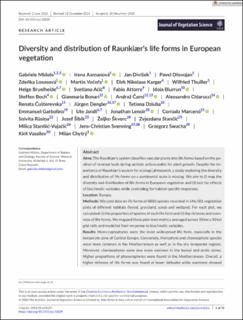Please use this identifier to cite or link to this item:
https://doi.org/10.21256/zhaw-29659| Publication type: | Article in scientific journal |
| Type of review: | Peer review (publication) |
| Title: | Diversity and distribution of Raunkiær's life forms in European vegetation |
| Authors: | Midolo, Gabriele Axmanová, Irena Divíšek, Jan Dřevojan, Pavel Lososová, Zdeňka Večeřa, Martin Karger, Dirk Nikolaus Thuiller, Wilfried Bruelheide, Helge Aćić, Svetlana Attorre, Fabio Biurrun, Idoia Boch, Steffen Bonari, Gianmaria Čarni, Andraž Chiarucci, Alessandro Ćušterevska, Renata Dengler, Jürgen Dziuba, Tetiana Garbolino, Emmanuel Jandt, Ute Lenoir, Jonathan Marcenò, Corrado Rūsiņa, Solvita Šibík, Jozef Škvorc, Željko Stančić, Zvjezdana Stanišić‐Vujačić, Milica Svenning, Jens‐Christian Swacha, Grzegorz Vassilev, Kiril Chytrý, Milan |
| et. al: | No |
| DOI: | 10.1111/jvs.13229 10.21256/zhaw-29659 |
| Published in: | Journal of Vegetation Science |
| Volume(Issue): | 35 |
| Issue: | 1 |
| Page(s): | e13229 |
| Issue Date: | 19-Jan-2024 |
| Publisher / Ed. Institution: | Wiley |
| ISSN: | 1100-9233 1654-1103 |
| Language: | English |
| Subjects: | Annual plant; Growth form; Plant functional trait; Plant life span; Shrub; Species richness; Tree |
| Subject (DDC): | 580: Plants (Botany) |
| Abstract: | Aims: The Raunkiær's system classifies vascular plants into life forms based on the position of renewal buds during periods unfavourable for plant growth. Despite the importance of Raunkiær's system for ecological research, a study exploring the diversity and distribution of life forms on a continental scale is missing. We aim to (i) map the diversity and distribution of life forms in European vegetation and (ii) test for effects of bioclimatic variables while controlling for habitat-specific responses. Location: Europe. Methods: We used data on life forms of 8883 species recorded in 546,501 vegetation plots of different habitats (forest, grassland, scrub and wetland). For each plot, we calculated: (i) the proportion of species of each life form and (ii) the richness and evenness of life forms. We mapped these plot-level metrics averaged across 50 km × 50 km grid cells and modelled their response to bioclimatic variables. Results: Hemicryptophytes were the most widespread life form, especially in the temperate zone of Central Europe. Conversely, therophyte and chamaephyte species were more common in the Mediterranean as well as in the dry temperate regions. Moreover, chamaephytes were also more common in the boreal and arctic zones. Higher proportions of phanerophytes were found in the Mediterranean. Overall, a higher richness of life forms was found at lower latitudes while evenness showed more spatially heterogeneous patterns. Habitat type was the main discriminator for most of the responses analysed, but several moisture-related predictors still showed a marked effect on the diversity of therophytes and chamaephytes. Conclusions: Our maps can be used as a tool for future biogeographic and macro-ecological research at a continental scale. Habitat type and bioclimatic conditions are key for regulating the diversity and distribution of plant life forms, with concomitant consequences for the response of functional diversity in European vegetation to global environmental changes. |
| URI: | https://digitalcollection.zhaw.ch/handle/11475/29659 |
| Related research data: | https://doi.org/10.5281/zenodo.10441454 |
| Fulltext version: | Published version |
| License (according to publishing contract): | CC BY-NC 4.0: Attribution - Non commercial 4.0 International |
| Departement: | Life Sciences and Facility Management |
| Organisational Unit: | Institute of Natural Resource Sciences (IUNR) |
| Appears in collections: | Publikationen Life Sciences und Facility Management |
Files in This Item:
| File | Description | Size | Format | |
|---|---|---|---|---|
| 2024_Midolo-etal_Diversity-and-distribution-of-Raunkiær-life-forms.pdf | 6.93 MB | Adobe PDF |  View/Open |
Show full item record
Midolo, G., Axmanová, I., Divíšek, J., Dřevojan, P., Lososová, Z., Večeřa, M., Karger, D. N., Thuiller, W., Bruelheide, H., Aćić, S., Attorre, F., Biurrun, I., Boch, S., Bonari, G., Čarni, A., Chiarucci, A., Ćušterevska, R., Dengler, J., Dziuba, T., et al. (2024). Diversity and distribution of Raunkiær’s life forms in European vegetation. Journal of Vegetation Science, 35(1), e13229. https://doi.org/10.1111/jvs.13229
Midolo, G. et al. (2024) ‘Diversity and distribution of Raunkiær’s life forms in European vegetation’, Journal of Vegetation Science, 35(1), p. e13229. Available at: https://doi.org/10.1111/jvs.13229.
G. Midolo et al., “Diversity and distribution of Raunkiær’s life forms in European vegetation,” Journal of Vegetation Science, vol. 35, no. 1, p. e13229, Jan. 2024, doi: 10.1111/jvs.13229.
MIDOLO, Gabriele, Irena AXMANOVÁ, Jan DIVÍŠEK, Pavel DŘEVOJAN, Zdeňka LOSOSOVÁ, Martin VEČEŘA, Dirk Nikolaus KARGER, Wilfried THUILLER, Helge BRUELHEIDE, Svetlana AĆIĆ, Fabio ATTORRE, Idoia BIURRUN, Steffen BOCH, Gianmaria BONARI, Andraž ČARNI, Alessandro CHIARUCCI, Renata ĆUŠTEREVSKA, Jürgen DENGLER, Tetiana DZIUBA, Emmanuel GARBOLINO, Ute JANDT, Jonathan LENOIR, Corrado MARCENÒ, Solvita RŪSIŅA, Jozef ŠIBÍK, Željko ŠKVORC, Zvjezdana STANČIĆ, Milica STANIŠIĆ‐VUJAČIĆ, Jens‐Christian SVENNING, Grzegorz SWACHA, Kiril VASSILEV und Milan CHYTRÝ, 2024. Diversity and distribution of Raunkiær’s life forms in European vegetation. Journal of Vegetation Science. 19 Januar 2024. Bd. 35, Nr. 1, S. e13229. DOI 10.1111/jvs.13229
Midolo, Gabriele, Irena Axmanová, Jan Divíšek, Pavel Dřevojan, Zdeňka Lososová, Martin Večeřa, Dirk Nikolaus Karger, et al. 2024. “Diversity and Distribution of Raunkiær’s Life Forms in European Vegetation.” Journal of Vegetation Science 35 (1): e13229. https://doi.org/10.1111/jvs.13229.
Midolo, Gabriele, et al. “Diversity and Distribution of Raunkiær’s Life Forms in European Vegetation.” Journal of Vegetation Science, vol. 35, no. 1, Jan. 2024, p. e13229, https://doi.org/10.1111/jvs.13229.
Items in DSpace are protected by copyright, with all rights reserved, unless otherwise indicated.